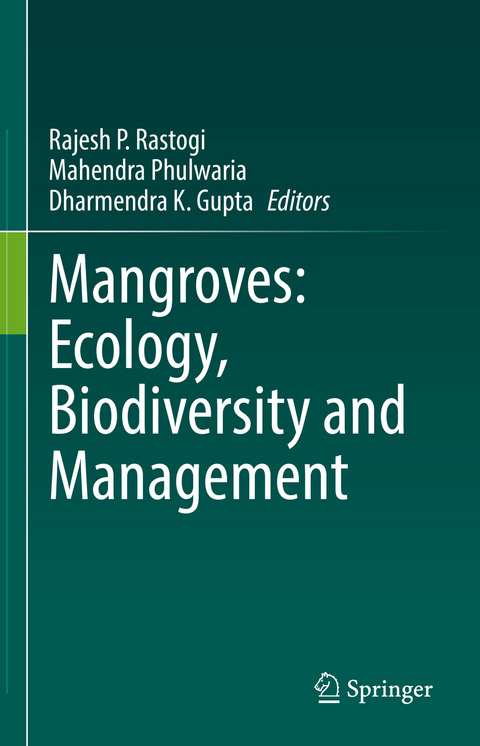
Mangroves: Ecology, Biodiversity and Management
Springer Verlag, Singapore
978-981-16-2493-3 (ISBN)
Dr. Rajesh P. Rastogi, Scientist, Research in Environment Division, Ministry of Environment, Forest & Climate Change (MoEF&CC), New Delhi 110 003, India Dr. Rajesh P Rastogi is scientist at Ministry of EF&CC, New Delhi, India. He obtained his graduate and post-graduate degree from Patna University, Bihar and completed PhD in Botany at Banaras Hindu University, Varanasi, India. Dr. Rastogi is the recipient of some national/international awards & fellowships. He was a visiting scientist at Friedrich Alexander University, Nuremberg, Germany and served as a visiting professor of biochemistry at Chulalongkorn University, Thailand. He has published several research/review papers in journals/Books of international repute and also edited some Books. His field of research includes freshwater/marine algae and cyanobacterial ecology, plant-physiology, phochemistry & photobiology and stress biology. Dr. Mahendra Phulwaria, Scientist, CS-I (Coral & Mangroves) Division, Ministry of Environment, Forest & Climate Change, New Delhi 110 003, India. Dr. Mahendra Phulwaria is Scientist at MoEF&CC, New Delhi, India. He received his Graduation from Maharshi Dayanand Saraswati University, and did Post-Graduation and PhD in Botany from Jai Narain Vyas University, Rajasthan, India. His main field of research is Plant Tissue Culture (Organogenesis, synthetic seed technology, in vitro conservation, micropropagation of woody and medicinal plants), and Molecular Biology (genetic diversity analysis using DNA barcoding). Dr. Phulwaria was awarded with SERB Young Scientist by Department of Science & Technology, New Delhi and Post-Doctoral Fellowship by UGC, New Delhi. He is a Member of International Association of Plant Biotechnology, India Chapter. Dr. Dharmendra K. Gupta, Scientist/Director, Ministry of Environment, Forest & Climate Change, New Delhi 110 003, India. Dr. Dharmendra K. Gupta is Scientist ‘F’ and Director (S) of Hazardous Substance Management Division in the Ministry of Environment, Forest and Climate Change, Government of India at New Delhi, India and already published more than 115 refereed research papers/review articles in peer reviewed international journals and in books, also edited 17 books from Springer. His field of research includes abiotic stress by radionuclides/heavy metals and xenobiotics in plants; antioxidative system in plants, environmental pollution (radionuclides/heavy metals) remediation through plants (phytoremediation). According to google scholar his total citation of research papers is more than 5000 and h-index is 36.
Chapter 1. Mangroves: Types and Importance.- Chapter 2. Biogeography of the Mangrove Ecosystem: Floristics, population structure and conservation strategies.- Chapter 3. Mangroves as feeding and breeding grounds.- Chapter 4. Factors influencing mangrove ecosystems.- Chapter 5. Energy Flux in Mangrove Ecosystems.- Chapter 6. Nitrogen and Phosphorus budget in mangrove ecosystem.- Chapter 7. Mangroves as a Carbon Sink/Stocks.- Chapter 8. Estimation of Blue Carbon stock of mangrove ecosystem and its dynamics in relation to hydrogeomorphic settings and land use-landcover.- Chapter 9. Responses of Mangrove Ecosystems to Climate Change in the Anthropocene.- Chapter 10. Roles of mangroves in combating the climate change.- Chapter 11. Role of mangroves in pollution abatement.- Chapter 12. Measurement and modeling of above-ground root systems as attributes of flow and wave attenuation function of mangroves.- Chapter 13. Mangrove as Natural Barrier to Environmental Risks and Coastal Protection.- Chapter 14. Diversity and community structure of polychaetes in mangroves of Indian coast.- Chapter 15. Structure and Diversity of Plants in Mangrove Ecosystems.- Chapter 16. Livelihood of Forest Dependent Dwellers in relation to the Exploitation of Resources at the fringe of Indian Sundarban.- Chapter 17. The Roles of Mangroves in Sustainable Tourism Development.- Chapter 18. Aquaculture in Mangroves.- Chapter 19. Ecological Valuation and Ecosystem Services of Mangroves.- Chapter 20. Management Action Plans for Development of Mangrove Forest Reserves.- Chapter 21. Geo-spatial tools for Mapping and Monitoring Coastal Mangroves.
| Erscheinungsdatum | 18.10.2021 |
|---|---|
| Zusatzinfo | 80 Illustrations, color; 27 Illustrations, black and white; XIII, 551 p. 107 illus., 80 illus. in color. |
| Verlagsort | Singapore |
| Sprache | englisch |
| Maße | 155 x 235 mm |
| Themenwelt | Naturwissenschaften ► Biologie ► Botanik |
| Naturwissenschaften ► Biologie ► Ökologie / Naturschutz | |
| ISBN-10 | 981-16-2493-3 / 9811624933 |
| ISBN-13 | 978-981-16-2493-3 / 9789811624933 |
| Zustand | Neuware |
| Informationen gemäß Produktsicherheitsverordnung (GPSR) | |
| Haben Sie eine Frage zum Produkt? |
aus dem Bereich


